 It was at Kosovo in 1389 that Serb met Turk in decisive battle with an aftermath lasting 500 years … and a legacy that haunts the Balkans even today.
It was at Kosovo in 1389 that Serb met Turk in decisive battle with an aftermath lasting 500 years … and a legacy that haunts the Balkans even today.
![]()
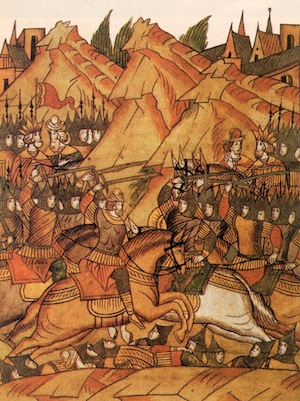
A tomb sits on the Plain of the Blackbirds, near where the rivulet known as the Lab flows into the Sitnica River. The Serbs call this region Kosovo Polje. It was the heart of the Serbian Empire for most of the Middle Ages, a valley of 4,200 square miles surrounded by hills, with Mount Kopaonik to the north and snow-capped Mount Shar to the south. Today, it lies within the borders of a truncated and strife-torn Yugoslavia, where Albania, Herzegovina and Macedonia meet.
The quiet tomb on this empty plain is a monument made of brick. Thick portals of chocolate-colored wood guard the entry, and the building sports a domed roof, above which is a crescent, symbol of the Muslim Turks who surged out of Anatolia and westward toward Europe in the 14th century. In this mausoleum lie the partial remains of Murad I, the Ottoman Sultan who, in 1389, defeated a Serbian-led Slavic Union intent on defending its homes and way of life against the invaders from the east. Murad died at Kosovo in 1389, but not before destroying Serbian independence for the next 500 years.
In the early morning hours of St. Vitus Day — June 15, 1389, according to the old calendar in use at that time, June 28 in the current one — the Serbian army prepared for battle. The Serbs were camped along the right bank of the Lab, terrain well suited to heavy cavalry and large infantry formations. The Serbian left wing was led by Vojvoda (Duke) Vlatko Vukovic, who had been sent by King Tvrtko I of Bosnia. The right was commanded by Dimitrije Vojonovic, a Serbian noble. Prince Lazar Hrebeljanovic, knez (king) of the Serbs, was in command of the center. His reserve force of infantry was led by Vuk Brankovic, the husband of his eldest daughter, Mara.
Assembled in the area of Nig and Kumanovo were the forces of Murad I. The Ottomans were flushed with pride and fresh from a succession of small victories in neighboring Bulgaria, where they had crushed Prince Sisman and extended their exploding empire as far as the banks of the Danube. Sisman, who had sought to save his throne and perhaps regain the ancient glory of his country, was now Murad’s vassal. The Turks seemed to be unstoppable.
Led by skilled veterans and imbued with a sense of righteousness, these descendants of a tiny band of nomadic tribesmen were poised to knife into the Balkans and inflict a bleeding wound that would fester for centuries. Their leader Murad, 70 years old, had led his warring nation for 30 years, tackling enemies in Asia Minor, penetrating Europe and establishing Adrianople as his capital. A recent defeat at the hands of the Bosnians had not given him pause in his quest for territory, staves and new citizens to tax. It had only served to whet his appetite for vengeance and conquest.
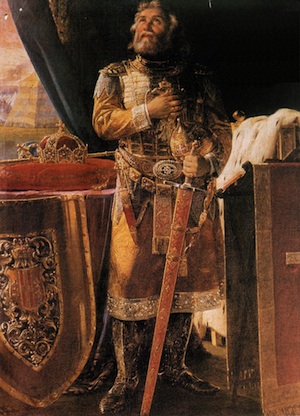
Serbian Prince Lazar did not want to fight. His army’s morale was low. Although Hungary was an ally, he had not had time to garner that powerful kingdom’s support against the Turkish invasion. And of his Slavic vassals, many were engaged in local rivalries or withstanding revolts that were tying down reinforcements from the north. There was disharmony even among his generals and nobles. His son-in-law Brankovic had become embroiled in a feud with Milos Obilic, the husband of Lazar’s younger daughter, Vukosava. The sisters had grown from squabbling children into adult enemies, and now, at the worst of times for Serbia, their husbands had been brought into the fray.
In addition to strife in his own camp, Lazar had to face the fact that potential friends had become his foes. Several Bulgarian and Serbian princes were ready to fight for the Turks. Men like Marko and Andrias, rulers of western Macedonia, became servants to Murad when the Ottoman army swept into Macedonia, Thrace and Bulgaria. Even Prince Sisman, who only the year before had fought Murad, released troops to the invaders, while Byzantine Emperor John Palaeologus supplied the sultan with men from his faltering empire. According to the feudal conventions that ruled the era, such leaders now were pledged to their conquerors. Feudal princes served their lords, not their people.
Lazar tried to take comfort in the knowledge that his union of Slavs was defending Christianity against the onslaught of Islamic conquest. While the Church did not declare his enterprise a holy crusade and attempt to garner more support for Serbia from the rest of Europe, there were many who realized that the Balkans stood as a bulwark against Islamic expansion into Europe proper. Christian Albanian chieftains, closely allied with the Serbs, marched to his banner under the leadership of John Castriota, who had mobilized a volunteer force of combined Serbian and Albanian infantrymen. Some Croatian units, caught up in the crusading fervor, also joined him.
Deep in the memories of some, as well as the songs of the bards, were tales of the Turks’ atrocities. When the Ottomans took Thrace in the 1360s, they massacred the defenders of the fortress at Chorlu and decapitated its commander. The act had been calculated to weave fear through the hearts of the Balkan defenders, but it had only served to strengthen their resolve.
On the night before battle, Lazar prepared himself and his followers by offering prayers and toasts of wine served in a golden goblet. He beseeched his fellow countrymen — and the assortment of Albanian tribesmen and Balkan volunteers who had flocked to his army — to be brave and true to their faith, saying to them, “The earthly kingdom is short-lived, but the Heavenly One is forever.” Lazar regarded this war with the Turks as Christianity’s last chance to defend Eastern Europe against Islam.

Such tragic forboding had not always marked the reign of Prince Lazar. Popular, respected by the Church as well as the Serbian nobility, he had been proclaimed knez after King Vukashin died fighting Murad’s forces at the Second Battle of Maritza in 1371. In addition to being a skilled soldier and a cultured man, Lazar enjoyed legitimacy as the Serbian ruler due to his marriage to Militza, the great granddaughter of Stefan Nemanj a founder of the Nemanjic dynasty and the man who had challenged the Byzantine Empire in the late 12th century and won recognition for the independence of his kingdom.
Backed by such support, Lazar fought the Turks wherever they appeared along the Serbian frontier. In 1381, and again in 1386, he thwarted Murad’s westward expansion. Tvrtko I, his Bosnian ally, gave further aid to the cause by defeating the Turks when they crossed the Vardar in 1388 and entered his territory. Murad’s army was outnumbered, and fully four-fifths of it was destroyed. For the Slavs, that was reason to rejoice. The Turks seemed less than invincible after all.
But the Ottoman forces the Balkan princes had stopped in Bosnia represented more of a reconnaissance-in-force than an army. A man of intelligence and resolution, both a statesman and a strategist, Sultan Murad slowly crafted an efficient war machine. He consolidated his position in Bulgaria’s interior and prepared for a much wider war with Serbia. Once he had secured the Bulgarian passes through the Balkan Mountains, he turned again to face Prince Lazar’s Slavic Union.
In 1326, during the reign of Sultan Urkhon, the Ottomans had gained a foothold in Europe when 80 men crossed the Hellespont on three rafts and attacked the castle of Tzympe, on the peninsula of Gallipoli. The raid was led by Murad’s older brother, Sulayman, who was designated to succeed their father, Urkhon, as sultan. In a short time, with the help of an earthquake that the Ottomans interpreted as God’s approval of their actions, the Turks secured this strategic site on the Sea of Marmora and held it as their gateway to a greater prize: Eastern Europe.
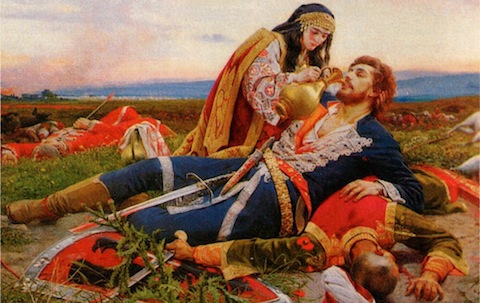
Three years after the raid on Gallipoli, Sulayman was killed when he fell from his horse. Urkhon received the news with dismay and soon died from grief at the age of 72. Murad, the son of a Greek girl forcibly taken by Urkhon, was anointed supreme lord of the Ottomans.
By the time Murad inherited the Ottoman sultanate, its nearest rival, the once-powerful Byzantine Empire, had been reduced to a crumbled shelt. The Byzantine capital, Constantinople, was rife with civil war. Thus, the great eastern heir of Imperial Rome was left only in bystander status as the Ottoman Turks then marched westward.
According to legend, the Ottomans were descended from a roving warrior band of 400 horsemen led by a tribal chieftain named Ertoghrul, who chose to side with a Seljuk sultan in a skirmish with Mongol marauders sometime in the latter part of the 13th century. Rewarded with land and the gratitude of the Seljuks, Ertoghrut’s people settled in Anatolia. After he died in 1288, his son, Osman, took the mantle of leadership and extended his people’s rule to the Black Sea and the Bosphorus. The Seljuk presence in Anatolia was crumbling; the Osmanlis, followers of Osman, expertly filled the vacuum.
Enamored with Islam, the Ottomans adopted that religion as their own, blending its martial call with their innate warrior nature. When Murad I, Osman’s grandson, ascended to the throne in 1359, the old Byzantine Empire sat closed off in the city of Constantinople, and the entire Anatolian Plain belonged to the Turks. Thessally, Macedonia, and western Thrace would soon be added as a new empire, poised to burst east and west. Fortune, land, slaves and taxes were the Ottomans’ primary concerns, with the spread of Islam in the conquered lands almost an afterthought. The Ottomans professed respect for the religions of their conquered peoples. The vanquished, however, sometimes employed conversion to Islam as their best means to evade slavery and punitive taxation.
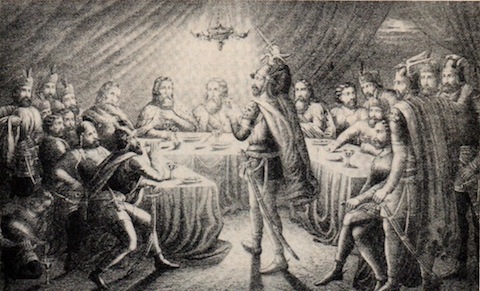
In 1389, with Bulgaria subdued, Sultan Murad penetrated deeper into the Balkans. He assaulted the Serbian fortress at Nish, where, for 25 days, the Serbs held out with all the heroics of a cornered and desperate people. When Nish fell, Murad received word that Lazar had assembled his army at Kosovo. Immediately seizing this opportunity to crush Serbian resistance in one decisive stroke and fulfill the destiny of the Osmanlis that he had inherited when he was declared sultan 30 years before, Murad marched to meet his enemy. Confident of victory, he ordered that the castles, churches, cities and villages that his armies captured should be left intact, not destroyed. Serbia was a rich and fertile country, and Murad wanted it to be useful for both his vassals and Muslim colonists imported from Asia Minor. Conquering scorched earth would add little to his empire’s coffers.
Awaiting the coming battle near the Lab, Murad took council from his veteran advisers. He had surrounded himself with skilled strategists who had served him well in previous campaigns. Following advice given by Evrenos Bey, a Greek who commanded the Ottoman army, Murad planned his attack for the dawn hours. Lazar and his nobles, meanwhile, prayed in the Samodrezha Church.
That night, a vile wind whipped the rocky plain. While Lazar admonished his followers to put aside personal quarrels, extinguish their distrust of one another, solidify this union of Slavic peoples and fight for victory, Sultan Murad prayed to God that the evil wind would abate. When morning broke, the air was calm and the Ottoman generals and captains marshaled their soldiers.
Murad commanded the center of the line with his personal guard of cavalry and jannissaries, the latter being the elite corps of archers and infantry that had begun as the sultan’s Imperial Guard and graduated to being one of the most fearsome fighting units in history. Alt of them were slaves, some born Christians, all the sons of the vanquished who had been taken as children, converted to Islam, and rigorously trained to fight for their sultan.
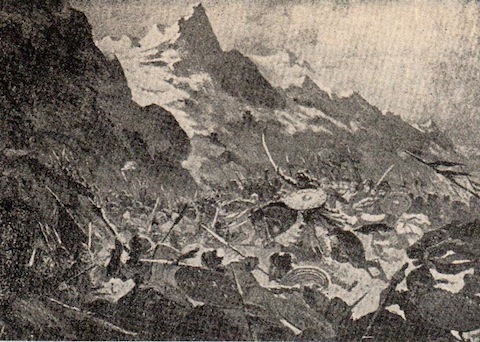
On the right flank stood Murad’s first born son Bayezid, commanding an assortment of Eastern European troops. Murad’s other son, Yakub, commanded the Asians who comprised the Ottoman left flank. Two thousand Turkish archers initiated the battle by launching a brutal frontal attack, and the irregular infantry, the azabs, were let loose to harass and tire the enemy. Cannons, a European invention, were employed by the Turks for the first time. The cumbersome fietdpieces were made of brass, which became the Ottomans’ favorite metal, since they had huge copper deposits in Anatolia and very little iron.
Enduring the punishment hurled at them by the archers and artillery, the Serbs began moving into attack formation. They massed on Murad’s left, then struck in one long, undulating wave, as though confident that they could break the onslaught by sheer will. Breaking through Yakub’s contingent, they routed the East Europeans, whom they probably considered traitors to the cause of Balkan independence, and then poured into the archers’ ranks. A Turkish regiment, boxed in and out-maneuvered, disintegrated.
The left wing began to crumble, and it looked as if the Serbian assault would carry the day for the Slavic Union. When Bayezid received the news of the disaster on the Turkish left flank, however, he wheeled from the right in a daring counterattack. Known as Yilderim — “Lightning” — among the Ottomans, Bayezid dashed into the battle swinging an iron mace while his men struck like a massive hammer at the Serbian flank.\
Thwarted by Bayezid’s quick-thinking action, the Serbian attack lost its impetus. Battered, the Serbs fell back in disarray, and now victory slipped quickly from their grasp. Seeing that, Lazar’s son-in-law Brankovic either lost his nerve or acted on a plan that had been prearranged with Murad. Taking his 12,000-man reserve with him — including the Croatian contingent, which up to that point had played only a minor role in the battle — he fled the battlefield, leaving Lazar and his loyalists in the proverbial lurch.

The day’s battle had ebbed and flowed from Balkan victory to Balkan defeat, but still the Serbs rallied to renew their attack. Prince Lazar personally whipped up enthusiasm and led his dedemoralized forces on a new foray into the Ottomans’ ranks. But his army, disheartened as a body and obviously still facing defeat, dwindled as soldiers died, fell wounded or deserted the cause.
Regardless of his flagging fortunes, Prince Lazar fought on. The night before, sensing that he was surrounded by men who might betray him, he had added a plea for unity to his toasts for victory. Turning to Milos Obilic, one of his sons-in-law, he had sought assurances of support. Lifting his golden goblet, Lazar had said, “Do not be faithless and take this golden cup from me as a souvenir.” Milos was indignant at the suggestion that he would betray his czar. Now, watching his soldiers desert and knowing that Brankovic had betrayed him by leaving the field, Lazar learned that Milos had been seen crossing over to the Ottoman lines.
Serbian morale plummeted. Lazar, wounded, was forced to throw down his sword and surrender, while what remained of his decimated army rapidly withdrew and dispersed across the plain. The war was over. Serbia had lost. Lazar was Murad’s prisoner.
According to the chroniclers, the erstwhile czar encountered a dying Milos when he was taken into the Ottoman camp. Perhaps from his son-in-law, or from a guard, he learned what had happened after Milos crossed the lines. Bent on proving his father-in-law wrong as-to his loyalty, Milos had presented himself to Sultan Murad as a traitor and claimed to have information that might help the Ottomans. Because of his high rank, he was ushered into Murad’s tent. There, Milos knelt in submission to kiss the sultan’s feet — and then suddenly he whipped out a concealed dagger and stabbed Murad twice in the chest. Ali Pasha, one of Murad’s advisers, tried to intervene and was struck dead with the same weapon. Unable to escape, Milos lunged at his angry captors and was quickly cut down. The outraged Turks then left him to die from his wounds.
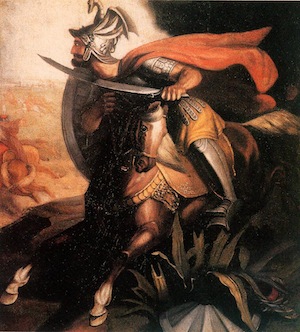
As a result of Milos’ double deception, Murad’s abdomen was cut open from roughly his groin to his chest. Yet still the 70-year-old campaigner grimly clung to life, while his physicians put his intestines back in his stomach and bound the terrible wound in a sheepskin. Murad knew he would not recover, but he was determined to stay alive long enough to have the satisfaction of seeing his enemies die before he did. Prince Lazar, on learning of Milos’s heroics, gave the man his blessing before being led to the dying sultan, whose final act in this short war was to condemn Lazar and the other captured Serbian nobles to death. The czar would be the first to die, although Lazar’s nobles begged to be beheaded first, thus assuring their sovereign a few more minutes of life. The request was denied and Murad’s son Bayezid prepared to carry out his father’s orders.
One of Lazar’s followers, Krajimir of Toplicta, asked to be allowed to hold his robe open under Lazar so the czar’s head would not touch the ground as it fell. Bayezid responded that expression of loyalty with his permission. Assembled outside Murad’s tent, the Serbs awaited execution, and Lazar turned to his nobles to offer a final farewell. As he began to speak, the Turks roughly pushed him to his knees, but before the sword struck his neck, Lazar managed to utter, “My God, receive my soul.”
Soon after all the captured nobles had been beheaded, Murad succumbed at last to his own wounds. Bayezid, as the eldest son, was proclaimed sultan of the Ottomans. To counter possible civil strife or rivalry, he took his brother Yakub prisoner and had him strangled with a bowstring, thereby assuring that no rival descendant could counter his claim to their father’s throne. That act of fratricide — perhaps impetuous, perhaps born from the knowledge that his brother was a popular commander who enjoyed the personal loyalty of his troops — began an Ottoman tradition that doomed a sultan’s younger sons for generations thereafter.
Secure now in his position as the victor of Kosovo and sultan of the Turks, Bayezid felt that he could afford to be gracious. He allowed the Serbs to retrieve Lazar’s head — it and the body were conducted to Prishtina and laid to rest at the Church of Vaznesenje Hristovo. Lazar’s son Stephen, one of the few nobles to have escaped the Turks, sought and was granted terms of surrender from Bayezid. Serbia was not incorporated into the Ottoman Empire as a nameless Turkish province, or sandjak; instead, it became a vassal state, with all the privileges and responsibilities that vassalage imposed. Stephen paid the Ottomans taxes, provided soldiers for the sultan’s army and became the Turks’first line of defense against a possibly resurgent Christian Eastern Europe. He also surrendered his sister Olivera, and Bayezid took her as a personal prize, adding the princess to his harem.
Where Murad was killed, the Turks eventually built a tomb and enshrined the fallen sultan by depositing his intestines in a coffin. The body was conducted back to Turkey, to the town of Broussa. Two Serbian nobles were forced to join the escort. When the body was laid to rest, they were executed by decapitation.
Bayezid soon after returned with his army to Asia Minor and fought a series of campaigns designed to enlarge the empire. In 1396, he destroyed a Western crusading army, jointly led by Burgundian Count Jean de Nevers and Hungarian Emperor Sigismund, at Nicopolis. A decisive factor in Bayezid’s victory was the cavalry provided by his newly acquired vassal, Serbia. Bayezid also succeeded in dominating nearly all of Anatolia but was unsuccessful in his siege of Constantinopte, the last Christian outpost in his domain. That setback was followed by a deeper tragedy, an incursion by Timur-i-Lenk (better known in the West as Tamerlane), whose Islamic Tatar empire bordered the Ottomans’ on the east. To keep Bayezid from encroaching on his holdings, Tamerlane invaded Anatolia, and on July 20, 1402, he outmaneuvered and routed the Turkish army at Ankara. Sultan Bayezid was captured, imprisoned in a wagon with iron bars, and forced to accompany the victorious army and endure the humiliation of seeing his harem (including Olivera) in Tamerlane’s hands. Finally, according to some accounts, Bayezid took poison and died.
Lazar’s wife, Militza, meanwhile, had sought refuge in religion. She became a nun, renouncing the material world for a life of solitude and prayer. She was joined by a companion, Princess Euphemia, whose husband had been killed by the Turks in an earlier battle. An embroideress of great talent, Euphemia spent her time in the convent fashioning a pall to drape upon Lazar’s body where the severed head rested against the neck.
To the Dechani Monastery, the largest of Serbia’s medieval churches, Militza gave a unique gift. It was a giant candle that she said should be lit only when the defeat at Kosovo had been avenged. More than 500 years had to pass before Serbian King Peter Karadjordjevic I fulfilled her wish, in 1913, although Serbia had finally been established as an independent kingdom by the Treaty of Berlin in 1878.
Eventually the Serbian Church declared Czar Lazar a saint and a martyr, and his remains were moved to the Ravanicsa Monastery. Meanwhile, Muslims swarmed into Serbia and Bosnia and established colonies. When the Turks moved into northern Serbia, Lazar was disinterred and removed to Srem which was in Hungary. Then, in 1941, in response to the pilfering and desecration of Serbian national shrines by the Nazi supported independent state of Croatia, Czar Lazar was taken to rest at the altar of an Orthodox cathedral in Belgrade.
The long-dead prince currently lies in a robe of faded red and gold brocade. A cloth, the one embroidered by Euphemia, hides the gap where his head is separated from his neck. His hands, black and mummified, are crossed over his loins. His feet have shrunken. They are encased in modern stockings and fitted into medieval boots of blue silk, woven with gold thread. Less than 40 years after gaining its independence, Serbia would again be overrun by invaders. The assassination of Austrian Archduke Franz Ferdinand in Sarajevo in 1914 led to a world war many times more devastating and treacherous than the great war that Lazar Hrebeljanovic had fought.
More recently, the legacy of Kosovo continues to haunt the Balkans in the form of recurring ethnic hatred between the Serbs and those southern Slavs who still practice the Muslim faith of the Turkish invaders — a bitter blood feud that has outlived the Ottoman occupation to the present day. Kosovo itself would be the scene of later battles and civil disturbances throughout those bitter centuries.
![]()
Recommended Reading
- The Ottoman Impact on Europe, Paul Coles.
- Kosovo, Bill Dorich, Basil W.R. Jenkins and Anita Dorich.
- The Saga of Kosovo, Alex N. Dragnich and Slavko P. Todorovich.
- Kosovo: Legacy of a Medieval Battle, Thomas Evert and Wayne Vucinich.
- The Ottoman Centuries: The Rise and Fall of the Turkish Empire, Lord Kinross
![]()
By David M. Castlewitz
Military History
March, 1994
| The Mind of Milosevic | Victory With Bitter Aftermath | Lingering Shadows Over the Balkans |
